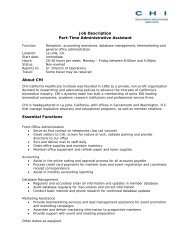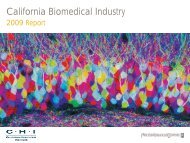Researcher profileRonald M. Evans, PhD, is a professorand March of Dimes Chair inMolecular and Developmental Biologyin the Gene Expression Laboratory atthe Salk <strong>Institute</strong>.How did you become interestedin diabetes and other metabolicdisorders?My interest has been in energyhomeostasis — how food is acquired,stored and burned. The underlyingproblem is that we are in the midst ofa pandemic of inactivity marked byan absence of movement or exercise.In our national state of sedentarybehavior it is a challenge for mostpeople to get the exercise they need.The result is increased weight gainand insulin resistance, which increaseobesity, diabetes, heart disease andhypertension.We began looking at nucleic receptors— a class of genetic switches thatcontrol transcription of the genesthat control the energy-burningnetwork of processes. That network isusually triggered by exercise, but wehypothesized that small molecules maygenerate the network to trick the musclecell into thinking it is being exercised.Genomic exercise, if you will.What are the fundamentalquestions in researching“genomic exercise.”We are trying to understand whatmuscle activity triggers at a metaboliclevel….The end chemical product ofexercise is the AMP kinase (AMPK),which is the master energy switch thatstarts to suck more sugars and fatsfrom blood into the muscle. In exercise,the kinase leaps into the nucleus [ofthe muscle cell] and activates the genenetwork, triggering a genetic cascade. Inthis way, AMPK converts stored energyinto chemical energy. The first challengewas to determine whether the genenetwork differentiates between physicaland nuclear effect. That is, could a smallmolecule trigger the same gene networkto behave in the same way as it reacts tophysical exercise?What have you found so far,and what might it mean forhuman applications?We have tested a few smallmolecules in sedentary mice for aperiod of one month. We showeddramatically improved performance —improvements that were about the sameas daily exercise. The treated mice hadlower blood sugars and lipids, improvedvascular performance and improvedmitochondria numbers.I think the work clearly demonstratesthat in mice, it is possible to developdrugs that have the capacity to enhancemuscle performance with out actuallyexercising. That is a major advance.It also identifies two key drug targetsfor which the next generation of moreeffective muscle-enhancing drugs canbe produced for people. In fact, thedrugs that we used have already beenin people. So now I would say it is goingto take a large pharmaceutical companyto develop the right type of program inmuscle biology.The challenge in bringing this forwardis getting the FDA to agree that frailtyand obesity can be treated with muscleenhancingdrugs. You have to curedisease to get a drug approved. Wethink we can make people a lot morehealthy. But making people healthy isnot an FDA approval end point. Weneed to educate the public and themedical community to move the FDAtoward accepting the benefits that canbe achieved by this kind of program.In your career so far, whathas been the discovery thathas fascinated you most?The growing realization that so muchof body physiology, endocrinology andbehavior is really about the controlof gene networks. My initial interestsin the early ‘80s were to study themechanics and logic of how the genomeis controlled. Our interests in cloninghormone receptors ultimately providedus with a key to unlock the secrets ofthe genome. In the beginning, science isabout overcoming technical challenges,which in the end open new avenues ofapproaching complex problems.What keeps you passionateabout science?Science to me is like the ultimate chessgame where the opponent is MotherNature. You’re trying to win secrets in anever-ending duel. There’s nothing thatis more thrilling than pitting yourselfagainst problems that are not yet solved.On working at The Salk <strong>Institute</strong>:The level of work and standards are veryhigh, and if you are not on the cuttingedge, you are not going to survive forlong. It’s not for everyone, but it is veryexciting and attractive to me. The Salkand La Jolla is a privileged place to be.We have a unique mix in the researchenvironment, with Salk, Scrippsand Sanford-Burnham, and a highconcentration of biotechnologyand pharmaceutical companies in avery tight zone.84 | <strong>California</strong> <strong>Biomedical</strong> <strong>Industry</strong> 2011 Report
The Salk <strong>Institute</strong> celebrates 50 years of excellence inbiological science researchToday, the institute has 61 seniorfaculty members and a scientific staffof more than 850. The latter groupincludes visiting scientists, about 285postdoctoral trainees, approximately130 graduate and rotation students, andmore than 90 undergraduate students.Although not a degree-grantinginstitution, the Salk has trainedmore than 2,000 scientists, many ofwhom have gone on to positions ofleadership in other prominent researchcenters worldwide. Five have won theNobel Prize. Four of the <strong>Institute</strong>’scurrent resident faculty members andthree nonresident fellows are NobelLaureates.After developing the vaccine for polio,a scientific accomplishment that madehim and his collaborators internationalheroes, Jonas Salk, M.D., embarked ona new dream. He wanted to establish aninstitute that would enable biologistsand other scientists to collaborate onresearch that would improve humanhealth. A New York virologist, Salktoured the country for more than ayear to find the perfect location for hisresearch center. At the same time, heshared his concept of free-flowing labsand collaborative spaces with worldrenownedarchitect Louis Kahn. Healso secured initial financial supportfrom the National Foundation/March ofDimes.When Salk discovered a 27-acre siteon Torrey Pines Mesa in La Jolla,overlooking the Pacific Ocean, heand Kahn were ready to proceed.The citizens of San Diego gifted theland to the institute in 1960, andgroundbreaking took place in 1962.Completed in 1967, the original institutebuildings were made to Salk’s order:spacious, unobstructed laboratoryspaces that could be adapted to theever-changing needs of science. Thebuilding materials had to be simple,strong, durable, and as maintenancefreeas possible. The facility wasdeclared an historic landmark in 1991.The institute houses 60 laboratoriesthat support research to expand thescientific understanding of cancer,aging, Alzheimer’s disease, diabetes,birth defects, Parkinson’s diseaseand AIDS. Researchers at Salk applyneuroscience, genetics, cell and plantbiology and related disciplines to probefundamental life science questions.The institute has been supported byfunds awarded to its members in theform of research grants, most fromNIH, and from private foundationsand individuals. The March of Dimes,which provided funds for the originalstructure, has contributed significantlyto the <strong>Institute</strong>’s financial needsannually ever since.<strong>California</strong> <strong>Biomedical</strong> <strong>Industry</strong> 2011 Report | 85






